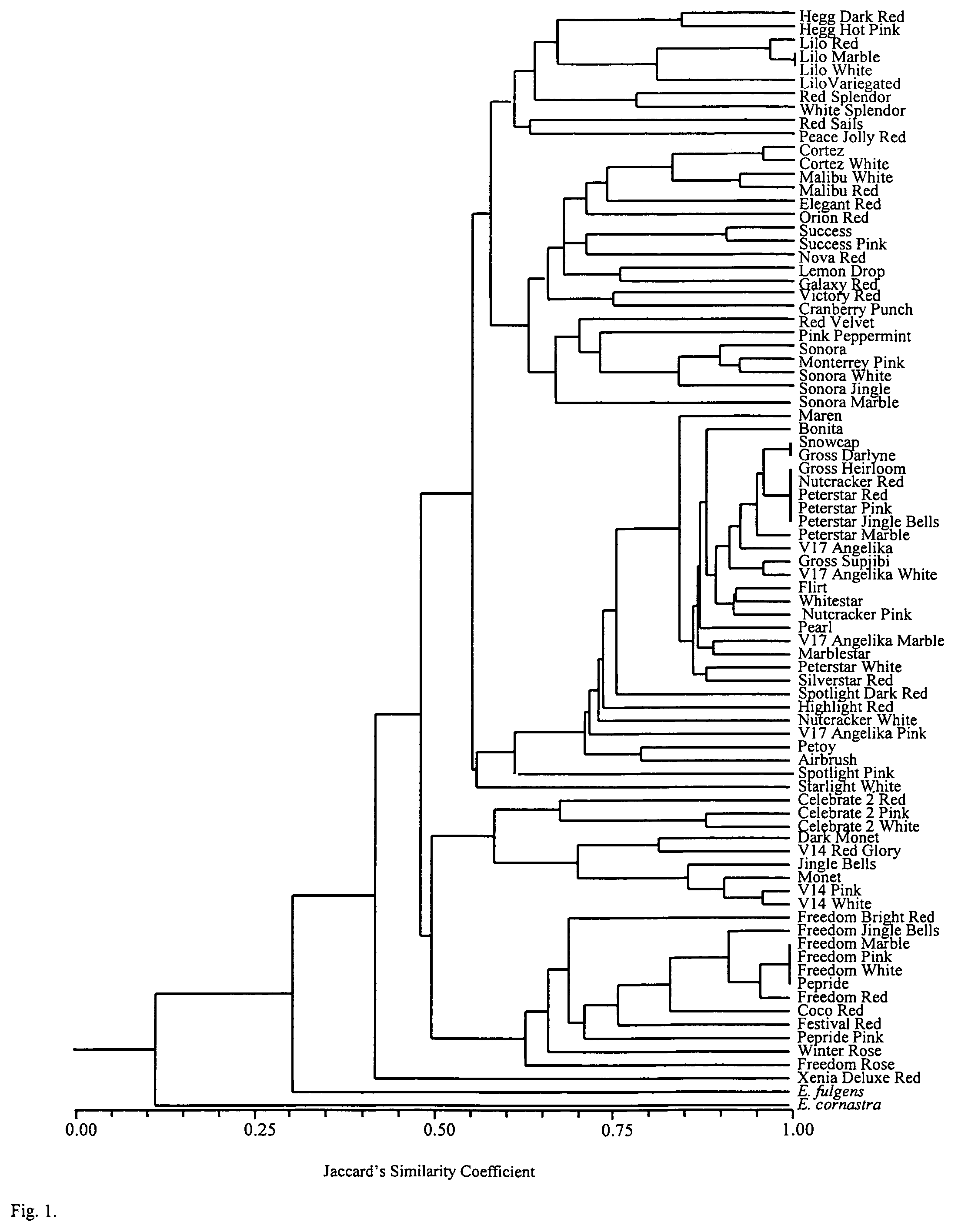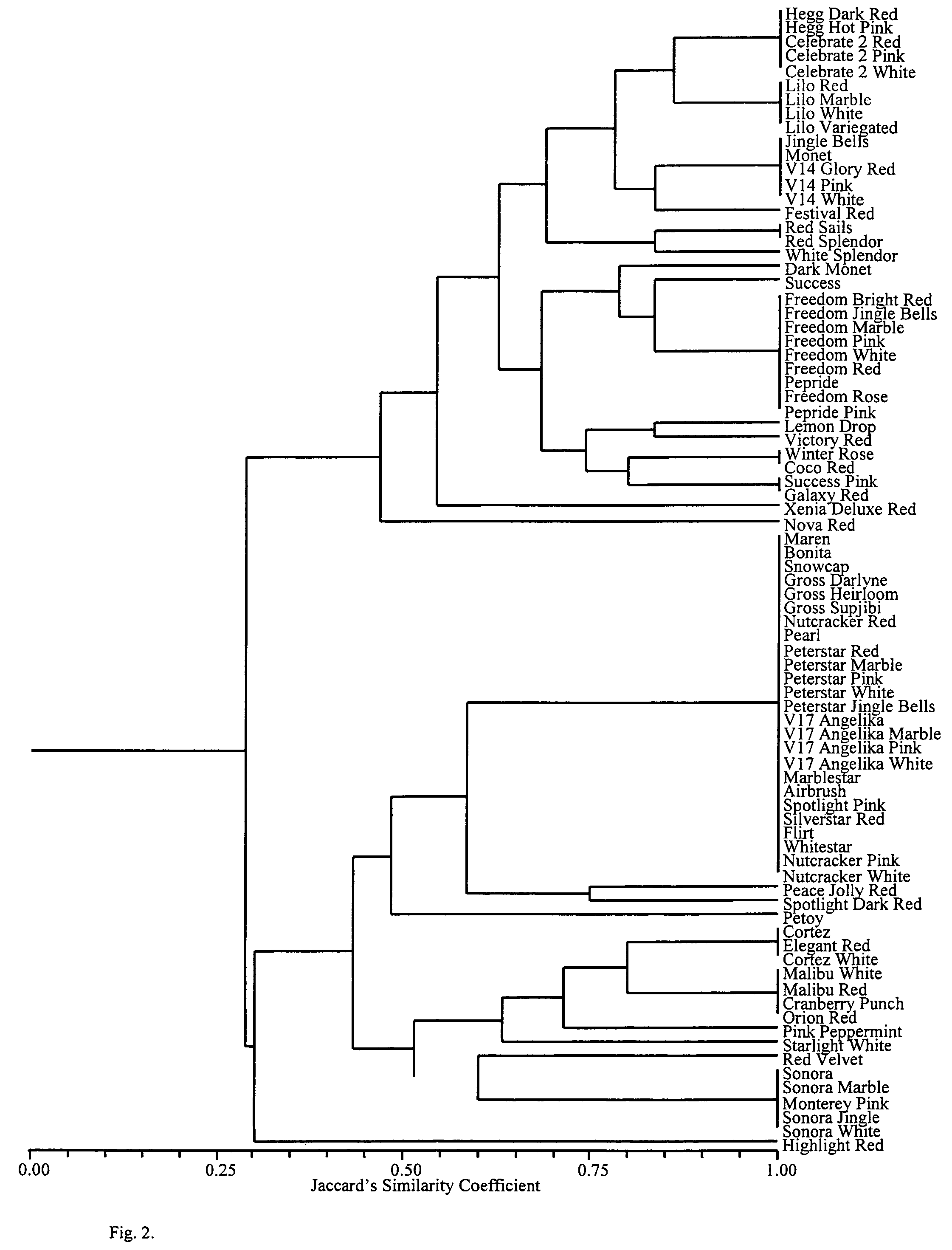Identification of poinsettia cultivars
a technology of poinsettia and cultivar identification, applied in the field of identification methods of plant cultivars, can solve the problems of inability to overcome the inherent heterogeneity of methods, inability to identify genotypes, and inability to use reliable cultivar identification technologies. to achieve the effect of sufficient intensity and separation
- Summary
- Abstract
- Description
- Claims
- Application Information
AI Technical Summary
Benefits of technology
Problems solved by technology
Method used
Image
Examples
example 1
Isolation and Amplification of Poinsettia Restriction Fragments
[0079]Genomic DNA was isolated from fully expanded poinsettia leaves using a modified benzyl chloride procedure (see Zhu et al, NucL. Acid Res. 21, 5279-5280 (1993)) and quantified by spectrophotometry. The AFLP protocol was performed essentially as described by Vos et al., Nucleic Acids Research 23, 4407-4414 (1995), using the commercially available AFLP Analysis System I™ (Life Technologies, Gaithersburg, Md.). The modifications made to the Life Technologies protocol included extending the length of time for the restriction digest incubation to an overnight incubation and extending the length of time for the ligation incubation to six hours at a lower temperature than that suggested by the manufacturer, in order to improve reproducibility in the final AFLP result. The AFLP fragments were electrophoresed on a 6% denaturing acrylamide gel for approximately two hours. The gel was fixed and dried, then exposed to a phospho...
example 2
Optimization of AFLP Analysis by Obtaining Optimal Primer Pairs
[0080]To determine optimal primer pairs for AFLP of poinsettia genomes, a two-level screening strategy was employed. Initially, four phytoplasma-free cultivars were tested with 64 primer pairs using AFLP Analysis System I™.
[0081]This screening allowed for a determination as to which primers were appropriate to use with poinsettia, and provided a first estimate of the number of polymorphisms each primer pair would detect that would allow us to differentiate different cultivars. The best four of these primer pairs were chosen based on the overall quality of the AFLP amplification and the number of fragment differences between the different cultivars. These four primer pairs were used to begin the AFLP evaluation of 70 cultivars. Fragments were selected for analysis if they were present in at least one phytoplasma-free cultivar, repeatable in multiple amplifications, and easily scored on the AFLP gel in terms of intensity a...
example 3
Secondary Primer Screening
[0082]The secondary primer screening began by selecting the 30 best primer pairs from the first screening using the same criteria as previously described. Twelve poinsettia genotypes were then chosen to screen the 30 primer pairs. Three genotypes served as controls for intracultivar variation and the remaining nine were chosen for their low distance classes. The primer pairs with the highest number of useful polymorphisms were scored and analyzed individually, then in different combinations until the distance classes were optimized.
[0083]The 32 fragments generated by the four most useful primer pairs were tested for intracultivar variation, and 19 of them were validated. These 19 fragments were added to the final database, bringing the total number of scored fragments to 41.
PUM
 Login to View More
Login to View More Abstract
Description
Claims
Application Information
 Login to View More
Login to View More - R&D
- Intellectual Property
- Life Sciences
- Materials
- Tech Scout
- Unparalleled Data Quality
- Higher Quality Content
- 60% Fewer Hallucinations
Browse by: Latest US Patents, China's latest patents, Technical Efficacy Thesaurus, Application Domain, Technology Topic, Popular Technical Reports.
© 2025 PatSnap. All rights reserved.Legal|Privacy policy|Modern Slavery Act Transparency Statement|Sitemap|About US| Contact US: help@patsnap.com



